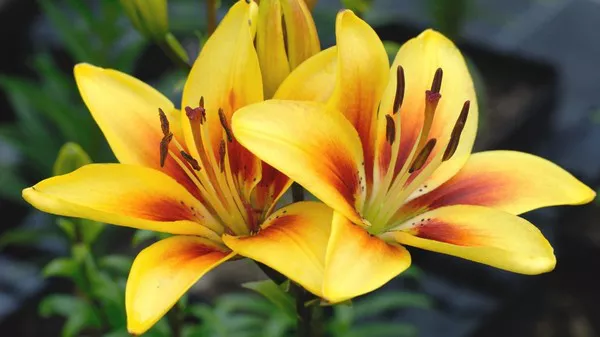Lilies, with their elegant and enchanting blossoms, have long captivated humanity with their beauty and symbolism. These iconic flowers hold diverse meanings across various cultures, religions, and historical contexts. From ancient mythology to modern-day rituals, the lily flower continues to be revered and cherished for its rich symbolism. In this article, we delve deep into the multifaceted meanings of the lily flower, exploring its significance in art, literature, religion, and beyond.
A Brief Overview of Lily Flower Symbolism
Before delving into the specific meanings attributed to the lily flower, it’s essential to understand its broader symbolism. Lilies are often associated with concepts such as purity, innocence, fertility, rebirth, and renewal. Their graceful appearance and delicate fragrance evoke feelings of serenity and tranquility, making them popular choices for various occasions, including weddings, funerals, and religious ceremonies.
The Lily in Ancient Mythology and Legend
The symbolism of the lily flower can be traced back to ancient civilizations, where it featured prominently in mythology and folklore. In Greek mythology, the lily was associated with various gods and goddesses, including Hera, the queen of the gods, who was often depicted wearing a crown of lilies. According to legend, lilies also sprang from the milk of Hera’s breast, symbolizing purity and motherhood.
In Christian tradition, the lily is often used as a symbol of purity and chastity, particularly in depictions of the Virgin Mary. Legend has it that the Archangel Gabriel presented Mary with a bouquet of white lilies to announce her divine pregnancy, hence establishing the flower’s association with purity and the Annunciation.
Cultural Meanings of Lily Flowers
The symbolism of lilies extends beyond the realms of mythology and religion, permeating various cultures and societies worldwide. In Chinese culture, the lily is revered as a symbol of motherhood and abundance, often associated with the goddess of mercy, Guanyin. Similarly, in Japanese culture, the lily (known as “yuri”) symbolizes purity, renewal, and transience, making it a popular motif in traditional art and literature.
In Western culture, different varieties of lilies carry distinct meanings. For example, the white lily is often associated with purity and virtue, while the orange lily symbolizes passion and desire. The Easter lily, with its trumpet-shaped blossoms, is commonly used to symbolize resurrection and rebirth, making it a popular choice for Easter celebrations.
Lily Flower Symbolism in Art and Literature
Throughout history, artists and writers have drawn inspiration from the symbolism of the lily flower, incorporating it into their works to convey deeper meanings and emotions. In Renaissance art, lilies were often depicted in religious paintings as symbols of purity and divine grace, accompanying depictions of the Virgin Mary and other holy figures.
In literature, lilies have been used as potent symbols in poetry, novels, and plays. William Wordsworth, in his poem “The Solitary Reaper,” uses the image of a lily to evoke feelings of melancholy and longing:
“Behold her, single in the field,
Yon solitary Highland Lass!
Reaping and singing by herself;
Stop here, or gently pass!
Alone she cuts and binds the grain,
And sings a melancholy strain;
O listen! for the Vale profound
Is overflowing with the sound.”
In Shakespeare’s works, lilies are often associated with themes of love, purity, and beauty. In “Sonnet 1,” the poet compares the beauty of a young man to that of a lily:
“From fairest creatures we desire increase,
That thereby beauty’s rose might never die,
But as the riper should by time decease,
His tender heir might bear his memory:
But thou, contracted to thine own bright eyes,
Feed’st thy light’s flame with self-substantial fuel,
Making a famine where abundance lies,
Thyself thy foe, to thy sweet self too cruel.”
Practical Uses and Cultivation of Lily Flowers
Beyond their symbolic meanings, lilies are also valued for their practical uses and ornamental beauty. With their wide range of colors, shapes, and sizes, lilies are popular choices for floral arrangements, garden borders, and landscaping projects. From the majestic Asiatic lilies to the delicate Calla lilies, there is a lily variety to suit every taste and preference.
Cultivating lilies can be a rewarding endeavor for gardeners of all skill levels. These resilient plants thrive in a variety of climates and soil conditions, making them suitable for gardens across the globe. With proper care and maintenance, lilies can bloom year after year, bringing joy and beauty to any landscape.
Conclusion
Conclusion, the lily flower holds a special place in the hearts and minds of people around the world, thanks to its rich symbolism and timeless beauty. From ancient mythology to modern-day celebrations, lilies continue to inspire awe and reverence, serving as powerful symbols of purity, love, and renewal. Whether adorning a wedding bouquet, gracing a religious altar, or simply brightening up a garden, the lily flower reminds us of the inherent beauty and symbolism found in nature.


